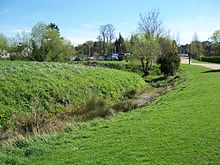
Ickenham is an area in Greater London, forming the northern part of Uxbridge and within the London Borough of Hillingdon.

Northwood is an area in the London Borough of Hillingdon, North West London, located 14.5 miles (23.3 km) north-west of Charing Cross. Northwood was part of the ancient parish of Ruislip, Middlesex. The area was situated on the historic Middlesex boundary with Hertfordshire, and since being incorporated into Greater London in 1965, has been on the Greater London boundary with that county.

Ruislip is a suburb in the London Borough of Hillingdon in West London. Prior to 1965 it was in Middlesex. Ruislip lies 13.8 miles (22.2 km) west-north-west of Charing Cross, London.
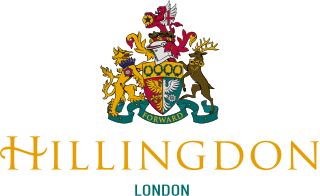
The London Borough of Hillingdon is a London borough in Greater London, England. It forms part of outer London and West London, being the westernmost London borough. It was formed in 1965 from the districts of Hayes and Harlington, Ruislip-Northwood, Uxbridge, and Yiewsley and West Drayton. The borough includes most of Heathrow Airport and Brunel University, and is the second largest of the 32 London boroughs by area.

Eastcote is a London Underground station in Eastcote in the west of Greater London. The station is on the Uxbridge branch of both the Metropolitan line and Piccadilly line, between Ruislip Manor and Rayners Lane stations. The station is located on Field End Road. It is in Travelcard Zone 5.

Eastcote is a suburban area in the London Borough of Hillingdon, in west London.

Ruislip-Northwood was a borough constituency represented in the House of Commons of the UK Parliament from 1950 to 2010 that elected one member (MP) by the first past the post system of election. It was centred on the districts of Ruislip and Northwood in the London Borough of Hillingdon.

Elthorne was a hundred of the historic county of Middlesex, England.

Uxbridge Rural District was, from 1894 to 1929, a local government district in Middlesex, England.
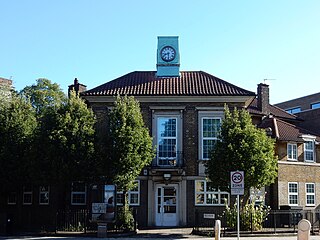
Yiewsley and West Drayton was a local government district in Middlesex, England from 1929 to 1965. Its area became the south-west of the London Borough of Hillingdon.

Ruislip Manor is an area of Ruislip in the London Borough of Hillingdon in West London. It is located approximately 13 miles (20.9 km) west north west of Charing Cross.

Ruislip Lido is a reservoir and artificial beach in Ruislip, within the London Borough of Hillingdon, England, situated between Ruislip Common, Ruislip Woods, and Poor's Field.

Ruislip Woods is a Site of Special Scientific Interest and national nature reserve covering 726 acres (294 ha) in Ruislip in the London Borough of Hillingdon. The woods became London's first national nature reserve in May 1997. Ruislip Local Nature Reserve at TQ 090 899 is part of the national nature reserve.

RAF Eastcote, also known over time as RAF Lime Grove, HMS Pembroke V and Outstation Eastcote, was a UK Ministry of Defence site in Eastcote, Middlesex.

Manor Farm is a 22-acre (8.9 ha) historic site in Ruislip, Greater London. It incorporates a medieval farm complex, with a main old barn dating from the 13th century and a farm house from the 16th. Nearby are the remains of a motte-and-bailey castle believed to date from shortly after the Norman conquest of England. Original groundwork on the site has been dated to the 9th century.

Highgrove House, also known as High Grove House or High Grove, is a Grade II listed mansion in the suburban area of Eastcote, within the London Borough of Hillingdon. Originally built in 1750 by the Reverend John Lidgould, the house was rebuilt in 1881 by Sir Hugh Hume-Campbell following a catastrophic fire. Along with Haydon Hall and Eastcote House, Highgrove was one of the three main houses of Eastcote and eventually became a residential hostel for homeless families, run by the local council from the 1960s until 2007. An area of the estate was sold to the local council in 1935 by the then-owner Eleanor Warrender to become what is now Warrender Park. In 1975, the house was granted Grade II listed status on account of its special architectural character.

Eastcote House Gardens is an area of public parkland in Eastcote, within the London Borough of Hillingdon. The site covers 3.63 hectares and incorporates the walled garden, dovecote and coach house of Eastcote House. The house was demolished in 1964 by the then Ruislip-Northwood Urban District Council (RNUDC), one of the predecessors of the London Borough of Hillingdon which was formed the following year. At the public's request, the garden and outbuildings were retained and are now maintained by a group of volunteers, the Friends of Eastcote House Gardens, in partnership with the local authority.
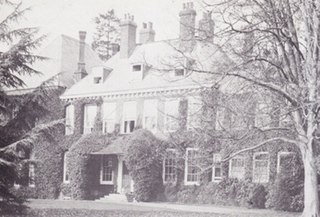
Haydon Hall was one of the three main houses of Eastcote, within what is now the London Borough of Hillingdon. The house was built in 1630 as a home for Lady Alice, Dowager Countess of Derby who had been living in Harefield. The house remained in the ownership of Lady Alice's descendants for several years, on the side of her eldest daughter. For a time the house was renamed "Eastcote Park" though was returned to the original name.
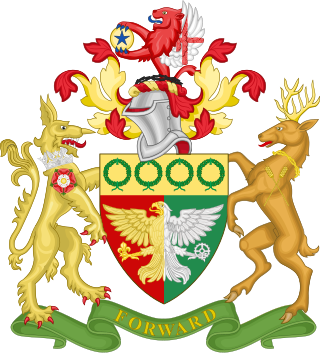
The coat of arms of the London Borough of Hillingdon is the official symbol of the London Borough of Hillingdon. They use elements from the coats of arms of the four previous districts. It is described as:
Arms: Per pale Gules and Vert an Eagle displayed per pale Or and Argent in the dexter claw a Fleur-de-lis Or and in the sinister claw a Cog-Wheel Argent on a Chief Or four Civic Crowns Vert.
Crest: On a Wreath of the Colours issuant from a Circlet of Brushwood Sable a demi-Lion Gules with wings Argent the underside of each wing charged with a Cross Gules and holding between the paws a Bezant thereon a Mullet Azure.
Supporters: On the dexter side an Heraldic Tiger Or gorged with an Astral Crown Azure and charged on the shoulder with a Rose Gules charged with another Argent barbed and seeded proper and on the sinister side a Stag proper attired and gorged with a Circlet of Brushwood and charged on the shoulder with two Ears of Rye slipped in saltire Or.
Motto: Forward.

